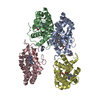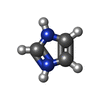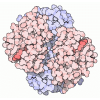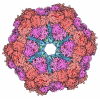+ Open data
Open data
- Basic information
Basic information
| Entry |  | |||||||||
|---|---|---|---|---|---|---|---|---|---|---|
| Title | MicroED structure of an Aeropyrum pernix protoglobin mutant | |||||||||
 Map data Map data | ||||||||||
 Sample Sample |
| |||||||||
 Keywords Keywords | MicroED / protoglobin / directed evolution / METAL BINDING PROTEIN | |||||||||
| Function / homology | Protoglobin / Globin-sensor domain / Protoglobin / Globin/Protoglobin / Globin-like superfamily / oxygen binding / heme binding / Protogloblin ApPgb Function and homology information Function and homology information | |||||||||
| Biological species |   Aeropyrum pernix (archaea) Aeropyrum pernix (archaea) | |||||||||
| Method | electron crystallography / cryo EM / Resolution: 2.1 Å | |||||||||
 Authors Authors | Danelius E / Gonen T / Unge JT | |||||||||
| Funding support |  United States, 2 items United States, 2 items
| |||||||||
 Citation Citation |  Journal: J Am Chem Soc / Year: 2023 Journal: J Am Chem Soc / Year: 2023Title: MicroED Structure of a Protoglobin Reactive Carbene Intermediate. Authors: Emma Danelius / Nicholas J Porter / Johan Unge / Frances H Arnold / Tamir Gonen /  Abstract: Microcrystal electron diffraction (MicroED) is an emerging technique that has shown great potential for describing new chemical and biological molecular structures. Several important structures of ...Microcrystal electron diffraction (MicroED) is an emerging technique that has shown great potential for describing new chemical and biological molecular structures. Several important structures of small molecules, natural products, and peptides have been determined using methods. However, only a couple of novel protein structures have thus far been derived by MicroED. Taking advantage of recent technological advances, including higher acceleration voltage and using a low-noise detector in counting mode, we have determined the first structure of an protoglobin (Pgb) variant by MicroED using an AlphaFold2 model for phasing. The structure revealed that mutations introduced during directed evolution enhance carbene transfer activity by reorienting an α helix of Pgb into a dynamic loop, making the catalytic active site more readily accessible. After exposing the tiny crystals to the substrate, we also trapped the reactive iron-carbenoid intermediate involved in this engineered Pgb's new-to-nature activity, a challenging carbene transfer from a diazirine via a putative metallo-carbene. The bound structure discloses how an enlarged active site pocket stabilizes the carbene bound to the heme iron and, presumably, the transition state for the formation of this key intermediate. This work demonstrates that improved MicroED technology and the advancement in protein structure prediction now enable investigation of structures that was previously beyond reach. | |||||||||
| History |
|
- Structure visualization
Structure visualization
| Supplemental images |
|---|
- Downloads & links
Downloads & links
-EMDB archive
| Map data |  emd_28615.map.gz emd_28615.map.gz | 19.4 MB |  EMDB map data format EMDB map data format | |
|---|---|---|---|---|
| Header (meta data) |  emd-28615-v30.xml emd-28615-v30.xml emd-28615.xml emd-28615.xml | 14.2 KB 14.2 KB | Display Display |  EMDB header EMDB header |
| Images |  emd_28615.png emd_28615.png | 181.2 KB | ||
| Filedesc metadata |  emd-28615.cif.gz emd-28615.cif.gz | 5.9 KB | ||
| Archive directory |  http://ftp.pdbj.org/pub/emdb/structures/EMD-28615 http://ftp.pdbj.org/pub/emdb/structures/EMD-28615 ftp://ftp.pdbj.org/pub/emdb/structures/EMD-28615 ftp://ftp.pdbj.org/pub/emdb/structures/EMD-28615 | HTTPS FTP |
-Validation report
| Summary document |  emd_28615_validation.pdf.gz emd_28615_validation.pdf.gz | 668.9 KB | Display |  EMDB validaton report EMDB validaton report |
|---|---|---|---|---|
| Full document |  emd_28615_full_validation.pdf.gz emd_28615_full_validation.pdf.gz | 668.5 KB | Display | |
| Data in XML |  emd_28615_validation.xml.gz emd_28615_validation.xml.gz | 4.5 KB | Display | |
| Data in CIF |  emd_28615_validation.cif.gz emd_28615_validation.cif.gz | 5 KB | Display | |
| Arichive directory |  https://ftp.pdbj.org/pub/emdb/validation_reports/EMD-28615 https://ftp.pdbj.org/pub/emdb/validation_reports/EMD-28615 ftp://ftp.pdbj.org/pub/emdb/validation_reports/EMD-28615 ftp://ftp.pdbj.org/pub/emdb/validation_reports/EMD-28615 | HTTPS FTP |
-Related structure data
| Related structure data |  8eumMC  8eunC M: atomic model generated by this map C: citing same article ( |
|---|---|
| Similar structure data | Similarity search - Function & homology  F&H Search F&H Search |
- Links
Links
| EMDB pages |  EMDB (EBI/PDBe) / EMDB (EBI/PDBe) /  EMDataResource EMDataResource |
|---|---|
| Related items in Molecule of the Month |
- Map
Map
| File |  Download / File: emd_28615.map.gz / Format: CCP4 / Size: 25.4 MB / Type: IMAGE STORED AS FLOATING POINT NUMBER (4 BYTES) Download / File: emd_28615.map.gz / Format: CCP4 / Size: 25.4 MB / Type: IMAGE STORED AS FLOATING POINT NUMBER (4 BYTES) | ||||||||||||||||||||||||||||||||||||
|---|---|---|---|---|---|---|---|---|---|---|---|---|---|---|---|---|---|---|---|---|---|---|---|---|---|---|---|---|---|---|---|---|---|---|---|---|---|
| Projections & slices | Image control
Images are generated by Spider. generated in cubic-lattice coordinate | ||||||||||||||||||||||||||||||||||||
| Voxel size | X: 0.51372 Å / Y: 0.48558 Å / Z: 0.50459 Å | ||||||||||||||||||||||||||||||||||||
| Density |
| ||||||||||||||||||||||||||||||||||||
| Symmetry | Space group: 1 | ||||||||||||||||||||||||||||||||||||
| Details | EMDB XML:
|
-Supplemental data
- Sample components
Sample components
-Entire : Homotetramer of Aeropyrum pernix protoglobin (ApePgb) C45G, W59L,...
| Entire | Name: Homotetramer of Aeropyrum pernix protoglobin (ApePgb) C45G, W59L, Y60V, V63R, C102S, F145Q, I149L mutant |
|---|---|
| Components |
|
-Supramolecule #1: Homotetramer of Aeropyrum pernix protoglobin (ApePgb) C45G, W59L,...
| Supramolecule | Name: Homotetramer of Aeropyrum pernix protoglobin (ApePgb) C45G, W59L, Y60V, V63R, C102S, F145Q, I149L mutant type: complex / ID: 1 / Parent: 0 / Macromolecule list: #1 |
|---|---|
| Source (natural) | Organism:   Aeropyrum pernix (archaea) Aeropyrum pernix (archaea) |
-Macromolecule #1: Protogloblin ApPgb
| Macromolecule | Name: Protogloblin ApPgb / type: protein_or_peptide / ID: 1 / Number of copies: 4 / Enantiomer: LEVO |
|---|---|
| Source (natural) | Organism:   Aeropyrum pernix (archaea) Aeropyrum pernix (archaea) |
| Molecular weight | Theoretical: 22.187307 KDa |
| Recombinant expression | Organism:  |
| Sequence | String: IPGYDYGRVE KSPITDLEFD LLKKTVMLGE KDVMYLKKAG DVLKDQVDEI LDLLVGWRAS NEHLIYYFSN PDTGEPIKEY LERVRARFG AWILDTTSRD YNREWLDYQY EVGLRHHRSK KGVTDGVRTV PHIPLRYLIA QIYPLTATIK PFLAKKGGSP E DIEGMYNA WFKSVVLQVA IWSHPYTKEN DW UniProtKB: Protogloblin ApPgb |
-Macromolecule #2: PROTOPORPHYRIN IX CONTAINING FE
| Macromolecule | Name: PROTOPORPHYRIN IX CONTAINING FE / type: ligand / ID: 2 / Number of copies: 4 / Formula: HEM |
|---|---|
| Molecular weight | Theoretical: 616.487 Da |
| Chemical component information |  ChemComp-HEM: |
-Macromolecule #3: IMIDAZOLE
| Macromolecule | Name: IMIDAZOLE / type: ligand / ID: 3 / Number of copies: 15 / Formula: IMD |
|---|---|
| Molecular weight | Theoretical: 69.085 Da |
| Chemical component information |  ChemComp-IMD: |
-Macromolecule #4: FE (III) ION
| Macromolecule | Name: FE (III) ION / type: ligand / ID: 4 / Number of copies: 4 / Formula: FE |
|---|---|
| Molecular weight | Theoretical: 55.845 Da |
-Macromolecule #5: water
| Macromolecule | Name: water / type: ligand / ID: 5 / Number of copies: 308 / Formula: HOH |
|---|---|
| Molecular weight | Theoretical: 18.015 Da |
| Chemical component information |  ChemComp-HOH: |
-Experimental details
-Structure determination
| Method | cryo EM |
|---|---|
 Processing Processing | electron crystallography |
| Aggregation state | 3D array |
- Sample preparation
Sample preparation
| Concentration | 20 mg/mL |
|---|---|
| Buffer | pH: 8 |
| Grid | Model: Quantifoil R2/2 / Material: COPPER / Mesh: 200 / Support film - Material: CARBON / Support film - topology: HOLEY / Pretreatment - Type: GLOW DISCHARGE / Pretreatment - Time: 30 sec. / Pretreatment - Atmosphere: OTHER |
| Vitrification | Cryogen name: ETHANE / Chamber humidity: 90 % / Chamber temperature: 277 K / Instrument: LEICA EM GP |
- Electron microscopy
Electron microscopy
| Microscope | FEI TITAN KRIOS |
|---|---|
| Temperature | Min: 77.0 K / Max: 90.0 K |
| Image recording | Film or detector model: FEI FALCON IV (4k x 4k) / Detector mode: COUNTING / Digitization - Dimensions - Width: 4096 pixel / Digitization - Dimensions - Height: 4096 pixel / Average electron dose: 0.00025 e/Å2 |
| Electron beam | Acceleration voltage: 300 kV / Electron source:  FIELD EMISSION GUN FIELD EMISSION GUN |
| Electron optics | C2 aperture diameter: 50.0 µm / Illumination mode: OTHER / Imaging mode: DIFFRACTION / Cs: 2.7 mm / Nominal defocus max: 0.0 µm / Nominal defocus min: 0.0 µm / Camera length: 2460 mm |
| Sample stage | Specimen holder model: FEI TITAN KRIOS AUTOGRID HOLDER / Cooling holder cryogen: NITROGEN |
| Experimental equipment |  Model: Titan Krios / Image courtesy: FEI Company |
- Image processing
Image processing
| Final reconstruction | Resolution.type: BY AUTHOR / Resolution: 2.1 Å / Resolution method: DIFFRACTION PATTERN/LAYERLINES / Software - Name: PHENIX (ver. 1.20.1-4487-000) |
|---|---|
| Crystallography statistics | Number intensities measured: 33826 / Number structure factors: 33826 / Fourier space coverage: 72 / R merge: 0.43 / Overall phase residual: 0 / High resolution: 2.1 Å / Shell - Shell ID: 1 / Shell - High resolution: 2.1 Å / Shell - Low resolution: 24.27 Å / Shell - Number structure factors: 33826 / Shell - Phase residual: 21.11 / Shell - Fourier space coverage: 73.1 / Shell - Multiplicity: 4.1 |
-Atomic model buiding 1
| Refinement | Space: RECIPROCAL / Protocol: OTHER / Overall B value: 26.51 / Target criteria: maximum likelihood |
|---|---|
| Output model |  PDB-8eum: |
 Movie
Movie Controller
Controller













 X (Sec.)
X (Sec.) Y (Row.)
Y (Row.) Z (Col.)
Z (Col.)




















